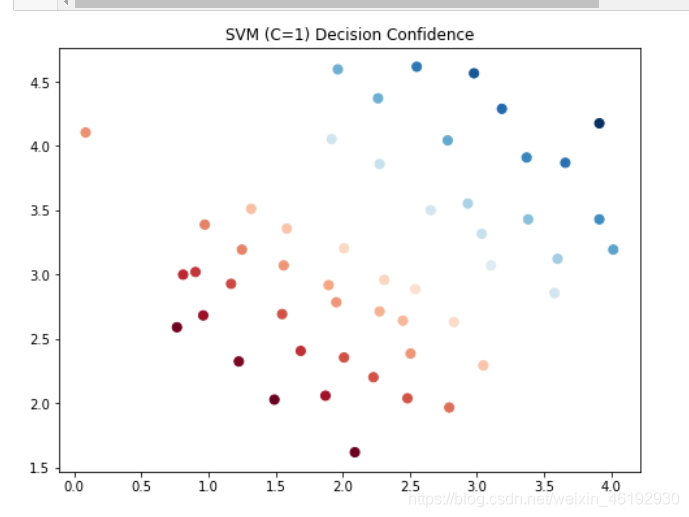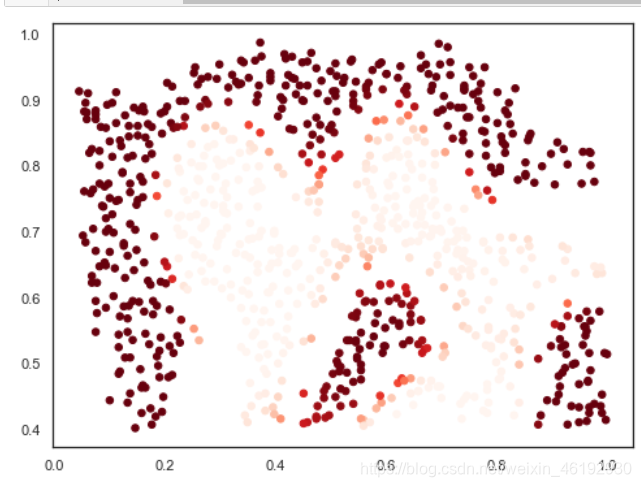SVM
import numpy as np
import pandas as pd
import sklearn.svm
import seaborn as sns
import scipy.io as sio
import matplotlib.pyplot as plt
mat = sio.loadmat('./data/ex6data1.mat')
print(mat.keys())
data = pd.DataFrame(mat.get('X'), columns=['X1', 'X2'])
data['y'] = mat.get('y')
data.head()
>>>
dict_keys(['__header__', '__version__', '__globals__', 'X', 'y'])
X1 X2 y
0 1.9643 4.5957 1
1 2.2753 3.8589 1
2 2.9781 4.5651 1
3 2.9320 3.5519 1
4 3.5772 2.8560 1
fig, ax = plt.subplots(figsize=(8,6))
ax.scatter(data['X1'], data['X2'], s=50, c=data['y'])
ax.set_title('Raw data')
ax.set_xlabel('X1')
ax.set_ylabel('X2')
plt.show()

svc1 = sklearn.svm.LinearSVC(C=1, loss='hinge',max_iter = 5000)
svc1.fit(data[['X1', 'X2']], data['y'])
svc1.score(data[['X1', 'X2']], data['y'])
>>> 0.9803921568627451
data['SVM1 Confidence'] = svc1.decision_function(data[['X1', 'X2']])
fig, ax = plt.subplots(figsize=(8,6))
ax.scatter(data['X1'], data['X2'], s=50, c=data['SVM1 Confidence'], cmap='RdBu')
ax.set_title('SVM (C=1) Decision Confidence')
plt.show()

svc100 = sklearn.svm.LinearSVC(C=100, loss='hinge',max_iter=30000)
svc100.fit(data[['X1', 'X2']], data['y'])
svc100.score(data[['X1', 'X2']], data['y'])
>>> 0.9803921568627451
data['SVM100 Confidence'] = svc100.decision_function(data[['X1', 'X2']])
fig, ax = plt.subplots(figsize=(8,6))
ax.scatter(data['X1'], data['X2'], s=50, c=data['SVM100 Confidence'], cmap='RdBu')
ax.set_title('SVM (C=100) Decision Confidence')
plt.show()

data.head()
X1 X2 y SVM1 Confidence SVM100 Confidence
0 1.9643 4.5957 1 0.798890 3.847069
1 2.2753 3.8589 1 0.381739 2.012868
2 2.9781 4.5651 1 1.374142 5.045087
3 2.9320 3.5519 1 0.520007 1.919674
4 3.5772 2.8560 1 0.334097 0.634728
加上高斯核
def gaussian_kernel(x1, x2, sigma):
return np.exp(- np.power(x1 - x2, 2).sum() / (2 * (sigma ** 2)))
x1 = np.array([1, 2, 1])
x2 = np.array([0, 4, -1])
sigma = 2
gaussian_kernel(x1, x2, sigma)
>>> 0.32465246735834974
sns.set(context="notebook", style="white", palette=sns.diverging_palette(240, 10, n=2))
sns.lmplot('X1', 'X2', hue='y', data=data,
height=5,
fit_reg=False,
scatter_kws={"s": 10}
)
plt.show()

svc = svm.SVC(C=100, kernel='rbf', gamma=10, probability=True)
svc.fit(data[['X1', 'X2']], data['y'])
svc.score(data[['X1', 'X2']], data['y'])
>>> 0.9698725376593279
predict_prob = svc.predict_proba(data[['X1', 'X2']])[:, 1]
fig, ax = plt.subplots(figsize=(8,6))
ax.scatter(data['X1'], data['X2'], s=30, c=predict_prob, cmap='Reds')
plt.show()

寻找最优参数
from sklearn.model_selection import GridSearchCV
from sklearn import metrics
mat = sio.loadmat('./data/ex6data3.mat')
training = pd.DataFrame(mat.get('X'), columns=['X1', 'X2'])
training['y'] = mat.get('y')
cv = pd.DataFrame(mat.get('Xval'), columns=['X1', 'X2'])
cv['y'] = mat.get('yval')
print(training.shape,cv.shape)
》》》(211, 3) (200, 3)
candidate = [0.01, 0.03, 0.1, 0.3, 1, 3, 10, 30, 100]
combination = [(C, gamma) for C in candidate for gamma in candidate]
len(combination)
>>> 81
search = []
for C, gamma in combination:
svc = svm.SVC(C=C, gamma=gamma)
svc.fit(training[['X1', 'X2']], training['y'])
search.append(svc.score(cv[['X1', 'X2']], cv['y']))
best_score = search[np.argmax(search)]
best_param = combination[np.argmax(search)]
print(best_score, best_param)
>>> 0.965 (0.3, 100)
best_svc = svm.SVC(C=100, gamma=0.3)
best_svc.fit(training[['X1', 'X2']], training['y'])
ypred = best_svc.predict(cv[['X1', 'X2']])
print(metrics.classification_report(cv['y'], ypred))
precision recall f1-score support
0 0.92 0.96 0.94 113
1 0.94 0.89 0.91 87
accuracy 0.93 200
macro avg 0.93 0.92 0.92 200
weighted avg 0.93 0.93 0.92 200
parameters = {'C': candidate, 'gamma': candidate}
svc = svm.SVC()
clf = GridSearchCV(svc, parameters, n_jobs=-1)
clf.fit(training[['X1', 'X2']], training['y'])
print(clf.best_params_,clf.best_score_)
>>> {'C': 30, 'gamma': 3} 0.9194905869324475
ypred = clf.predict(cv[['X1', 'X2']])
print(metrics.classification_report(cv['y'], ypred))
>>> precision recall f1-score support
0 0.95 0.96 0.96 113
1 0.95 0.93 0.94 87
accuracy 0.95 200
macro avg 0.95 0.95 0.95 200
weighted avg 0.95 0.95 0.95 200
- C 过大,高方差,与lambda反着,,
- 标准差过大,高偏差,过小 高方差(过拟合)
- 不使用核函数就是线性核函数
- 当 特征 大于数据 的数量(10倍) 使用logistic or 非线性核 SVM
- 当 n 较小,m 还行 n(1–1000) m(10—10000) 可以使用高斯核SVM
- 当n 小,m 大 n(1–1000) m>50000 需要更多的特征就是用 logistic 或 线性核函数,使用有核的就慢很多。



























 1523
1523

 被折叠的 条评论
为什么被折叠?
被折叠的 条评论
为什么被折叠?








